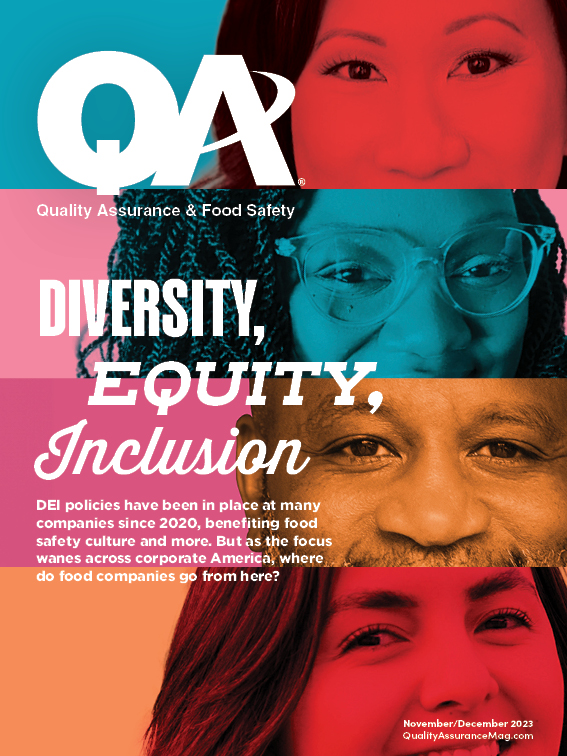
Over the last few months, there have been a number of high-profile recalls related to foreign materials in food, from steel and bone to rocks and plastic. Although foreign material presence is continuously one of the top reasons for recalls, it does not tend to have as strict a focus by senior management as do other adulteration causes, such as pathogens and chemicals. Perhaps this is exactly why related recalls have risen.
Foreign material presence can occur at any step of the food chain due to a variety of reasons, from supplier issues to equipment failures to packaging or food prep errors. So, it is critical that a food business focuses on prevention in its supplier management program as well as at its own facility.
Suppliers. Your supply chain can introduce significant foreign material risk to your processes as well as the finished product, particularly when a raw material is further processed by a supplier. To aid in prevention, start by understanding what is going on upstream and the efforts being made by suppliers to control the presence and inclusion of foreign material in their ingredients. Ensure that your supplier agreement specifies what is acceptable and what is not in terms of foreign material, and that the supplier agrees to the specifications. Ensure your supplier program includes specifications for high-risk suppliers, and provide regular review of both supplier and co-manufacturer programs. Once an ingredient arrives at the plant, the facility should have a system in place to monitor for the presence of foreign material and controls to extract where possible.
At the Facility. Failing equipment can be a primary source of risk, so it is important to have a program to define control measures, devices and intervention that are needed at different points throughout the line. The program should include preventive maintenance practices for the facility and equipment, regular inspection of both, and the reassessment of control strategies at any manufacturing or equipment change. Additionally, applicable use and regular validation of metal detectors, magnets, X-ray equipment or optical sorters can all help mitigate risk. This needs to include requirements for product rejection, what is to be done with rejected product and corrective action.
Operationally, a risk assessment of your processes and potential sources of foreign material should be conducted. An example of this is the failure modes and effects analysis tool, by which you can systematically conduct a risk assessment to determine most likely sources of foreign material in your operations. Once identified, you can implement control measures and devices to help prevent the risk, with both the assessment and controls supported by written validation.
Foreign material presence can occur at any step of the food chain due to a variety of reasons.
A facility’s sanitation program is also integral to foreign object control, both as a control and in supplementing controls. That is, having a thorough sanitation program helps to remove potential foreign object risk and enables preventive maintenance by ensuring equipment is inspected for wear and tear as it is cleaned.
Finally, it is essential to have a training program that educates all employees — from those on the line to those in corner offices — about the risk of foreign objects and the importance of the control program to the overall food safety management strategy of the company. Forming a foreign material committee, which meets at least quarterly and conducts semi-annual inspections, also can be a good way to keep the focus on facility controls and develop corrective actions where needed.
Food Safety Culture. In a business with a strong food safety culture flowing throughout its organization and supply chain, employees embrace and align with best practices as part of the food safety management system. This is built by ensuring that all are aware of potential hazards, recognize the importance of their control and are empowered to act when they see a hazard, such as the threat of foreign material getting into a product.
The strength of the organization’s food safety culture can also be a strong determinant of risk. A mature culture is one of the most effective ways to migrate from a reactive to a preventive approach to addressing conditions that can result in foreign material in finished product, by anticipating and preventing those occurrences.

Explore the November December 2023 Issue
Check out more from this issue and find your next story to read.
Latest from Quality Assurance & Food Safety
- Scentian Bio Wins Top Prize at IFT FIRST Startup Pitch Competition
- Evigence Debuts FreshSense to Change How Food Industry Measures Freshness
- Acme Releases Automated Scraper Strainer
- Mitzi Baum to Step Down as CEO of Stop Foodborne Illness
- USDA ARS Scientists Develop Pectin That Gels with Low-Sugar Products
- GS1 US Celebrates 50-Year Barcode 'Scanniversary' and Heralds Next-Generation Barcode to Support Modern Commerce
- New Florida Extension Agent Will Teach Stakeholders About Food Safety
- Athletic Brewing Company Announces $50 Million Equity Financing Round Led by General Atlantic





